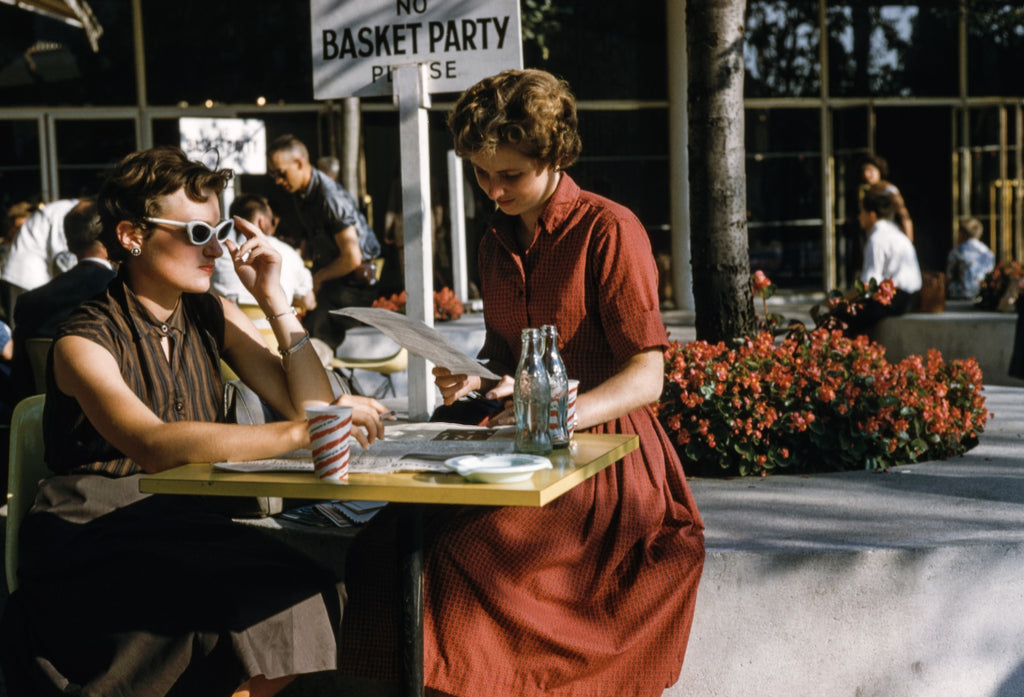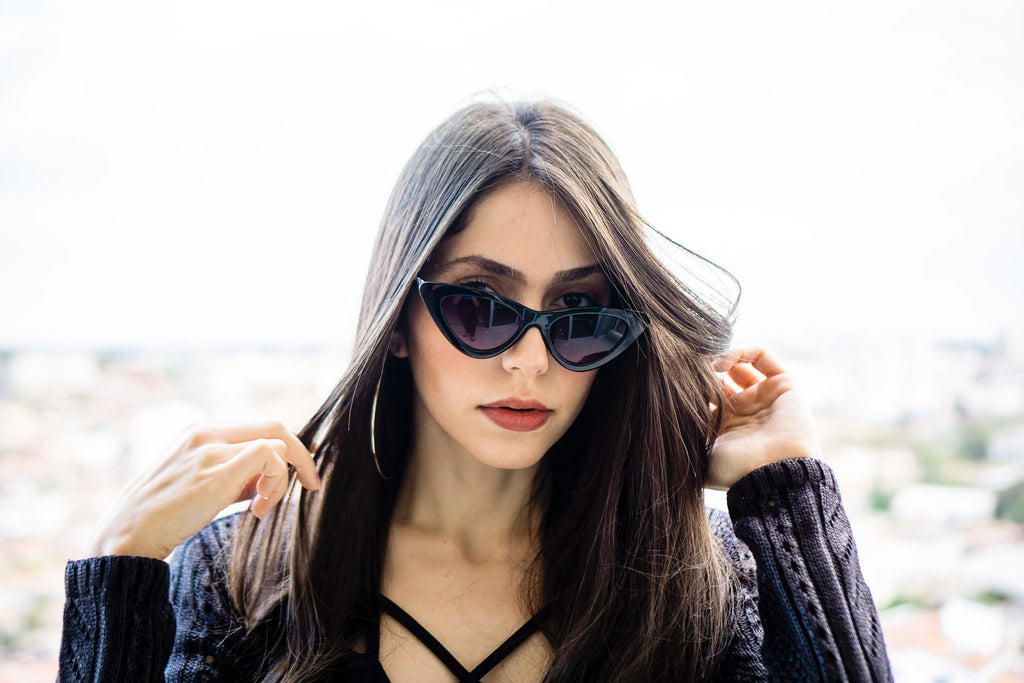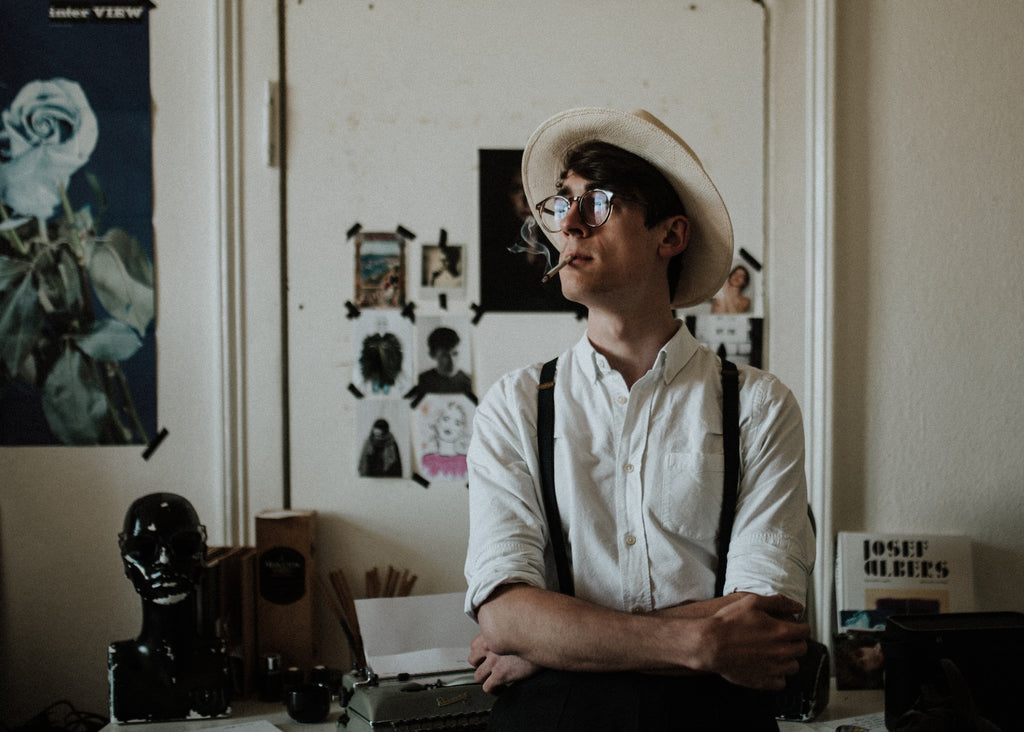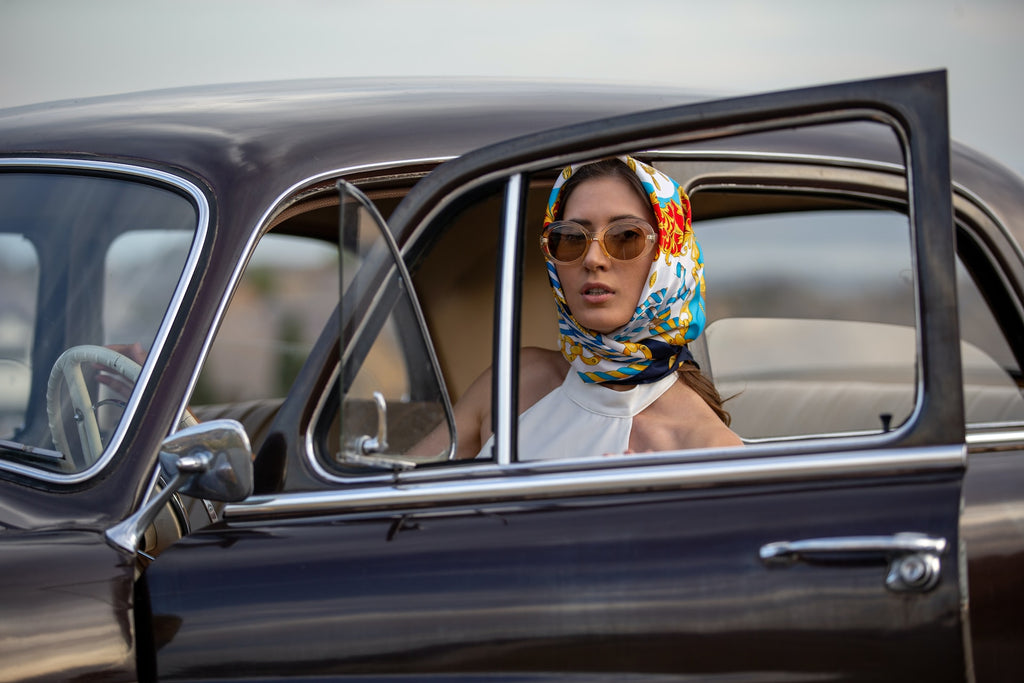
In the Eye of Classic: The Enduring Style of Vintage Eyewear Explored
Reading Time: about
Hello there! I'm glad you've decided to step into the world of vintage eyewear with me. It's a world filled with charm, elegance, and timeless style that's survived the decades.
Whether you're a fan of fashion history, a connoisseur of style, or just curious about what makes vintage glasses so appealing, this blog post is for you. We'll explore the allure of vintage eyewear, its impact on modern fashion, and answer all the pressing questions you've been pondering.
So sit back, adjust your frames, and let's dive into the captivating world of vintage eyewear together.
1. A Brief on Vintage Eyewear
Let's rewind a bit for context. When I say vintage eyewear, I'm referring to glasses that date back at least two decades. Now, that's not a hard-and-fast rule because, in the world of fashion, the term "vintage" often blends seamlessly with "retro" and "antique". The point is, vintage eyewear is all about looking back, appreciating our history, and savoring the craftsmanship and aesthetics of bygone eras.
In essence, vintage eyewear is a blast from the past, with designs ranging from the minimalist to the extravagant, from horn-rimmed spectacles of the 1920s, cat-eye frames popularized in the 1950s, to aviator sunglasses that took flight in the 1930s. Each of these iconic styles paints a picture of their respective eras, giving us a glimpse into the past while adding a touch of timeless elegance to our current fashion repertoire.
2. Why Vintage Eyewear Continues to Fascinate
As I delve deeper into this nostalgic journey, I can't help but wonder: what is it about vintage eyewear that continues to fascinate us?
Well, for one, it's a perfect blend of form and function. These pieces were not just designed to improve vision or protect our eyes from the sun, they were also intended to make a fashion statement, and boy, did they deliver! Each piece is a testament to the craftsmanship of the past, reminding us of a time when every detail mattered, when quality wasn't compromised for quantity.
Moreover, vintage eyewear tells a story. Each pair is a piece of history, a relic from a bygone era that speaks volumes about the culture, style, and fashion trends of the time. Wearing a pair of vintage frames is like donning a piece of art - it's expressive, it's distinctive, and it's uniquely you.
But perhaps what fascinates us most about vintage eyewear is the paradox it presents. Even as we push forward in the age of technological innovation and fast fashion, we find ourselves drawn to these fragments of the past, these tangible reminders of our journey through time. It's this nostalgic allure, this longing for a simpler time, that keeps us enthralled, and why, I believe, vintage eyewear will never go out of style.

I. The History of Vintage Eyewear
1. The Early Days of Eyewear
The Emergence of Eyeglasses
In our journey through the annals of fashion history, let's start at the very beginning. Picture this: the year is around 1290, and we're in Italy, where the first wearable eyeglasses emerged. Initially, these were rudimentary contraptions, more practical than aesthetic. They were merely magnifying glasses bound together by a rivet, held up directly in front of the eyes to help with reading. There were no stylish frames or temples to rest upon the ears, as we have today.
Evolution of Eyewear Designs
Fast forward a couple of centuries, and we see the evolution in eyewear designs gaining momentum. They began as simple aids to improve vision but soon transformed into accessories that were reflective of one's status and style. In the 18th century, the invention of sidepieces that rested on ears made glasses more comfortable and easy to wear. It's fascinating how these designs, initially grounded in practicality, have evolved into such fashionable accessories.
2. Pivotal Moments in Eyewear History
Introduction of Sunglasses
Now, let's step into the era of the Roaring Twenties, when sunglasses made their grand debut. Initially designed to protect pilots' eyes during flights, they soon became popular among the public. Think about how these pairs not only shield our eyes but also exude an undeniable coolness. Sam Foster was the man behind this innovation, selling the first mass-produced sunglasses in Atlantic City, New Jersey, in 1929.
The Rise of Designer Eyewear
As we cross into the mid-20th century, eyewear took a decidedly fashionable turn. The late 1960s marked the birth of designer eyewear. Big fashion houses like Gucci and Christian Dior started producing their line of glasses. Eyewear was no longer just a vision aid or a shield from the sun; it became an essential fashion accessory. A beautiful blend of function and fashion, wouldn't you agree?
3. Vintage Eyewear Through the Decades
Iconic Styles from the 1920s to the 1990s
As we move through the ages, we see eyewear styles evolving dramatically, mirroring societal changes. Cat-eye glasses, symbolic of the 50s and 60s, conveyed a sense of glamour and femininity. The groovy 70s saw oversized frames becoming popular, while the 80s and 90s embraced a variety of styles from quirky geometric shapes to minimalist designs. These iconic styles continue to inspire modern eyewear trends, lending a classic touch to contemporary fashion.
Influential Figures in Eyewear Fashion
While we're looking back, it's worth mentioning how influential figures in history have shaped eyewear fashion. Remember the teashade glasses that John Lennon made famous in the 60s? Or Audrey Hepburn's unforgettable oversized sunglasses in "Breakfast at Tiffany's"? These style icons have left a lasting legacy in the world of vintage eyewear, shaping trends and making glasses more than just a necessity but an emblem of personal style.

II. Notable Vintage Eyewear Styles
As a connoisseur of vintage eyewear, I've come to appreciate the history and charm behind every style. Each tells a unique story and is a reflection of the era it originated from. Today, we'll delve into three iconic vintage eyewear styles that have endured the test of time: cat-eye glasses, aviator glasses, and round frames.
1. Cat-Eye Glasses
Did you know cat-eye glasses first made their appearance in the 1930s? It wasn't until the 1950s and 1960s, though, that they reached the peak of their popularity. Initially, they were designed with the aim to provide women a larger field of vision. Over time, their upward flare at the outer edges turned into a symbol of femininity and fashion. If you've ever looked at photos of style icons from this era, like Audrey Hepburn and Marilyn Monroe, you'll surely see them donning a pair of these distinctive glasses.
These glamorous frames have found their way back into modern fashion, embodying both a vintage appeal and a certain contemporary edginess. They are a symbol of individuality, perfect for someone who wants to make a style statement. A word of advice? If you're planning on investing in cat-eye glasses, they look fantastic on diamond and square face shapes!

2. Aviator Glasses
Next up, aviator glasses. I must confess, aviators hold a special place in my heart. They were originally developed in 1936 for pilots, hence the name, to protect their eyes while flying. These glasses were characterized by their large, often tinted lenses and thin metal frames. Sound familiar? You've likely seen these on movie stars like Tom Cruise in 'Top Gun'.
The popularity of aviator glasses has transcended decades. They continue to be a staple in eyewear fashion, appreciated for their blend of practicality and effortless style. Aviators can be a great addition to any outfit, adding a touch of classic allure. Ideal for those with heart-shaped faces, these glasses are more than just an accessory—they're a statement.

3. Round Frames
Last but not least, round frames. These became widely popular in the 1920s and have strong associations with the literary and intellectual crowds. Ever heard of John Lennon? His name is practically synonymous with round glasses. Originally, these frames were designed to cover as much of the wearer's field of vision as possible.
Their charm lies in their simplicity and versatility. Round frames have made a resurgence in recent years, and it's not hard to see why. They are loved for their vintage appeal and the touch of quirkiness they add to one's look. They work beautifully with square or angular face shapes. So, if you're looking to mix up your style with a hint of vintage, round frames might just be the choice for you!
In the world of eyewear, styles come and go, but these three have shown an incredible staying power. Do any of these pique your interest? Which style resonates with your personal aesthetic? I'd love to hear your thoughts in the comments below!

III. How to Identify Genuine Vintage Eyewear?
As an eyewear enthusiast, I understand the thrill of owning a piece of history that has stood the test of time. One such piece is vintage eyewear. These iconic frames have a distinctive style and quality that set them apart from their contemporary counterparts. But how can you identify genuine vintage eyewear? There are a few key features you need to look out for.
1. Key Features to Look Out For
Unique Markings
Every now and then, I come across vintage glasses that carry distinct markings. These markings could be manufacturer symbols, patent numbers, or style names etched into the frame. Oftentimes, you'll find these inscriptions on the inner part of the temple or bridge. You might need a magnifying glass to see them clearly. However, don't forget, absence of markings doesn't mean the eyewear isn't vintage. Some manufacturers didn't add these details, especially in the early days.
Quality of Material
Hold a pair of vintage glasses and you'll immediately notice the difference in weight and texture. The quality of materials used in vintage eyewear is often superior to today's mass-produced frames. Most vintage frames are made from zyl (zylonite or cellulose acetate) or metal, including gold and silver. The materials feel sturdy, substantial, and have a unique patina that only time can create.
2. Differences Between Vintage and Retro
While vintage and retro eyewear may appear similar to the untrained eye, there are crucial differences that set them apart.
Design Comparisons
As someone who’s seen countless glasses, I can tell you that each era has a distinct style. Vintage glasses are generally more conservative in design, reflecting the aesthetic sensibilities of their time. Retro eyewear, on the other hand, is a modern reinterpretation of vintage styles. It borrows design elements from the past, but with a contemporary twist. For instance, vintage cat-eye glasses typically have subtle curves and smaller lenses, while their retro versions are more exaggerated and dramatic.
Material and Manufacturing Process
In the past, eyewear was handmade, reflecting careful craftsmanship. Frames were cut from sheets of acetate or metal, then buffed and polished to perfection. In contrast, retro eyewear is usually mass-produced using modern techniques and materials, such as injection molding for plastic frames. These frames, although sturdy and well-designed, don't quite capture the authenticity and character of true vintage eyewear.
In your quest for the perfect pair of vintage glasses, remember, the details are in the craftsmanship, the material, and the design. By understanding these differences, you're well on your way to finding an authentic piece of wearable history.
Remember, you're not just buying glasses, you're buying a story that dates back decades, maybe even a century. Now, isn't that something worth treasuring? I certainly think so.
IV. Why Vintage Eyewear is a Fashion Statement?
When it comes to expressing personal style, vintage eyewear holds a unique allure. It's not merely about donning glasses; it's about making a fashion statement that embodies an aesthetic that's timelessly chic.
1. The Appeal of the Vintage Aesthetic
As a fervent admirer of vintage eyewear, I’ve noticed that its influence spans across pop culture and modern fashion alike.
Vintage Eyewear in Pop Culture
Think back to Audrey Hepburn's iconic oversized tortoiseshell sunglasses in "Breakfast at Tiffany's" or John Lennon's round wire-framed glasses that have come to symbolize a whole era. These pieces are far more than simple accessories. They've left an indelible mark on popular culture and have shaped the way we perceive vintage eyewear. When you slip on a pair of vintage glasses, you become part of this rich history, bringing a touch of cinematic glamour to your everyday style.
Vintage Eyewear in Modern Fashion
If we delve into the realms of modern fashion, we'll see how top designers and fashion houses continually derive inspiration from vintage eyewear. From Gucci's recent resurrection of oversized frames reminiscent of the 70s to Tom Ford's reinterpretation of the classic Aviator style, vintage trends find their way back into our wardrobes every season. Wearing vintage eyewear connects you to these modern interpretations, helping you remain at the forefront of fashion trends.
2. Personal Expression Through Vintage Eyewear
Vintage eyewear goes beyond trend-following; it's an expression of individuality, a nod to your distinctive style.
How to Choose Vintage Glasses for Your Style
Choosing the perfect vintage glasses to express your personality can be an adventure in itself. Are you drawn to the bold statement of cat-eye frames, or do you prefer the subtle sophistication of round tortoiseshell glasses? Your choice of vintage eyewear tells a story about you. It might hint at a fondness for a bygone era or a desire to stand out from the crowd. In my own journey, I've found that understanding the history and symbolism behind each style has deepened my connection to my vintage pieces.
The Influence of Celebrity Vintage Eyewear Styles
We can't deny the impact of celebrity styles on our fashion choices. From Marilyn Monroe's glamorous cat-eye glasses to Johnny Depp's quirky round frames, these style icons have shown us how vintage eyewear can be a defining element of personal style. As we take cues from their looks, we're not just emulating their style; we're interpreting it, infusing it with our individuality, and continuing the legacy of vintage eyewear.

V. The Resurgence of Vintage Eyewear
It's fascinating to see how cyclical fashion can be. It feels like just yesterday, sleek modern designs dominated the eyewear scene. But here we are, witnessing the renaissance of classic, vintage eyewear styles. Let's delve deeper into this resurgence and see what it's all about.
1. Modern Interpretations of Vintage Styles
There's a beautiful dialogue happening between the past and the present in the eyewear industry. This connection is palpable when we look at how contemporary brands take inspiration from the past.
Contemporary Brands with Vintage Inspirations
Some of today's most sought-after eyewear brands borrow heavily from vintage designs. It's not about copying or replicating the old, rather it's about reinterpreting and celebrating the classic. Brands such as Warby Parker, Oliver Peoples, and Ray-Ban have skillfully incorporated vintage aesthetics into their product lines. They have demonstrated that a well-crafted pair of vintage-style glasses can be both a fashion statement and a nod to history.
Innovation in Vintage Eyewear Design
While the inspiration may come from the past, the innovation is thoroughly modern. Today's eyewear manufacturers are using state-of-the-art materials and technologies to create vintage-inspired glasses that are more durable, comfortable, and user-friendly than their historical counterparts. By merging classic aesthetics with contemporary performance, they're striking a balance that resonates with a broad audience.
2. Sustainable Fashion and Vintage Eyewear
The resurgence of vintage eyewear is not just about aesthetics. It's part of a broader shift towards sustainable fashion, a movement that values quality over quantity and longevity over fast-fashion trends.
The Role of Vintage in Reducing Fast Fashion
Every time we choose a pair of vintage glasses over a new pair, we are reducing the demand for new resources and energy. Vintage eyewear, especially the well-preserved ones, are often made to a standard that outlasts most of the present-day eyewear. By choosing vintage, we're not just making a style statement but also contributing to a more sustainable fashion ecosystem.
The Process of Restoring Vintage Eyewear
There's an art to bringing old eyewear back to life, and it's an increasingly popular one. Restoration professionals are leveraging modern technology and age-old techniques to restore and refurbish vintage frames, ensuring they're ready for their second life. This restoration process not only extends the lifecycle of these frames but also preserves the charm and personality that only comes with age.
Let's not see this as just a trend but rather a recognition of the timeless appeal of vintage designs, the love for sustainable fashion, and the delight in breathing new life into old glasses. After all, what's old is new again.

How to Care for Your Vintage Eyewear
1. Cleaning and Maintenance Tips
When it comes to vintage eyewear, proper maintenance is everything. But, how should you go about it? You might wonder. Well, the first step involves keeping them clean.
Safe Cleaning Methods
Now, when I say 'cleaning', I don't mean just running your glasses under the tap. I learned that this could lead to water spots or even scratch the lenses. So, what I usually recommend is to gently wipe your vintage eyewear using a microfiber cloth. This soft fabric won't scratch your glasses and can effectively remove dust and smudges.
For a deeper cleanse, make a mixture of lukewarm water and a drop of mild dish soap. Dip your microfiber cloth into this solution and carefully clean the lenses and frames. After cleaning, always dry your glasses with a clean, dry cloth to avoid any water spots.
Long-term Storage for Vintage Eyewear
When you're not wearing your vintage glasses, where do you store them? If you're anything like me when I first started collecting, you might just lay them down on the nearest surface. But I quickly learned that proper storage can significantly prolong their life.
I found that investing in a hard-shell eyeglass case can protect your glasses from scratches, dust, and accidental breakage. Additionally, storing your glasses in a cool, dry place will help to avoid any damage from high temperatures or humidity.
Restoration and Repair
Now, let's say that despite your best efforts, your favorite pair of vintage glasses got damaged. Do not despair! There are several options available.
2. When to Consider Professional Restoration
If the damage seems beyond a simple fix, like a broken frame or a cracked lens, it might be time to consider professional restoration. I've seen experts work magic on vintage eyewear, restoring them to their former glory. Remember, your vintage glasses are a piece of history, and sometimes they need a professional touch to keep them in tip-top shape.
DIY Repairs and Enhancements
On the other hand, if the damage is minor, like a loose screw or a misaligned frame, then a DIY repair might just do the trick. Over the years, I've compiled a little toolbox for such emergencies. It includes a glasses repair kit with a variety of screws, a micro screwdriver, and a magnifier.
A word of caution though! Always handle your vintage eyewear with care when attempting DIY repairs. The last thing you want is to cause more damage to your precious specs.
Remember, treating your vintage eyewear with respect not only preserves their quality and longevity but also allows you to enjoy their timeless beauty for longer. So, care for them like you would any treasured item, and they'll continue to add that unique touch to your style for years to come.
Conclusion
So, there you have it! Vintage eyewear is truly a world of its own, offering a rich tapestry of history, aesthetics, and personal expression. These timeless pieces hold a charm that transcends decades, captivating us with their unique styles and enduring quality.
Whether you're looking to add a touch of individuality to your look, connect with the past, or simply make a fashion statement, vintage eyewear delivers on all fronts. Embracing the vintage eyewear trend is more than just a style choice; it's a celebration of history, art, and personal identity. After all, as they say, the eyes are the windows to the soul, and what better way to frame them than with glasses that have a soul of their own?
Here's to the enduring allure of vintage eyewear - may it continue to inspire, fascinate, and captivate for many more years to come.
FAQ
What is vintage eyewear?
When I think about vintage eyewear, I'm taken back to eras where glasses were more than just a vision aid - they were a fashion statement! Vintage eyewear refers to glasses that were designed and produced from the 1920s to the 1980s. These glasses, whether optical or sunglasses, are adored for their distinctive shapes, intricate detailing, and exceptional craftsmanship. A piece of history, they showcase past eras' unique aesthetics and design philosophies.
Why is vintage eyewear so popular?
Well, isn't that the question of the hour? Vintage eyewear's popularity can be credited to a few key factors. First, there's the undeniable charm of nostalgia, the allure of a time gone by. These pieces tell a story, encapsulating the essence of past eras. Secondly, vintage glasses are unique. Unlike mass-produced modern frames, vintage styles are often rare or even one-of-a-kind, giving wearers a sense of individuality. Plus, let's not forget the enduring quality of these pieces. They were built to last and they've certainly stood the test of time!
How can I identify authentic vintage glasses?
This is an important one! Authenticating vintage eyewear can be a little tricky, but with a keen eye, you can master it. Look for unique markings - many manufacturers inscribed their brand name, the frame model, and sometimes even the production year. Check the quality of the material. Vintage glasses were usually made from sturdy materials like acetate or metal. And don't be afraid to research. The internet is a treasure trove of information - use it!
What's the difference between vintage and retro eyewear?
Ah, the age-old debate of vintage versus retro. While often used interchangeably, there's a subtle difference between the two. Vintage eyewear is typically older, authentic pieces from previous eras, while retro eyewear is newly made but designed to mimic the styles of the past. If you're after a genuine piece of history, vintage is your go-to. If you're more interested in the aesthetic than the authenticity, retro will do the trick.
What are some iconic vintage eyewear styles?
Let me paint a picture here - imagine the glamorous cat-eye frames of the '50s, favored by Hollywood stars like Marilyn Monroe. Or the oversized round glasses of the '70s, symbolic of the hippie era. How about the cool aviator sunglasses of the '80s, sported by Tom Cruise in Top Gun? Each decade gifted us with iconic eyewear styles that continue to inspire modern designs.
Where can I buy authentic vintage eyewear?
Hunting for vintage eyewear can feel like a thrilling treasure hunt. Specialist vintage stores and online marketplaces like Etsy and eBay are good starting points. Just remember to do your research and ask questions if you're unsure. Happy hunting!
How do I maintain and clean vintage glasses?
Taking care of your vintage eyewear is essential to prolong their lifespan. Clean the lenses gently with lens cleaner and a soft cloth, avoid harsh chemicals on the frames, and always store them in a protective case. If you're dealing with a stubborn issue, professional eyewear stores often offer cleaning and maintenance services.
Can vintage eyewear be restored or repaired?
Absolutely! Restoring vintage eyewear can often bring them back to their former glory. This should typically be handled by professionals who understand the delicate nature of these pieces. From replacing lenses to repairing frames, experts can often breathe new life into worn-out glasses.
How can I match vintage eyewear to my personal style?
This is the fun part! Whether your style is minimalist, bohemian, or full-on glamour, there's a pair of vintage glasses waiting for you. Consider your wardrobe, your lifestyle, and your personal taste. If you're a bold dresser, go for standout frames like cat-eye or oversized styles. If you prefer a subtler look, round or rectangular frames might be more up your alley.
How does vintage eyewear influence modern designs?
As they say, fashion is cyclical, and eyewear is no exception. Modern designers often draw inspiration from vintage eyewear, reinventing classic shapes with a contemporary twist. Whether it's the '70s-style round glasses seen on today's runways or the cat-eye frames gracing Instagram feeds, vintage eyewear's influence is everywhere!
📫 Related Blog Posts:
📌 Journey Through Lenses: Crafting Your Ultimate Travel Photo Album
📌 Master the Art of Travel Photography: A Comprehensive Guide
📌 Nike ACG - How Nike Stepped Up in the Outdoor Sector?
📌 The Top 10 Best Nike Shoes of All Time
📌 Air Travel 101: Master the Art of Comfortable Flight Journeys





























Leave a comment